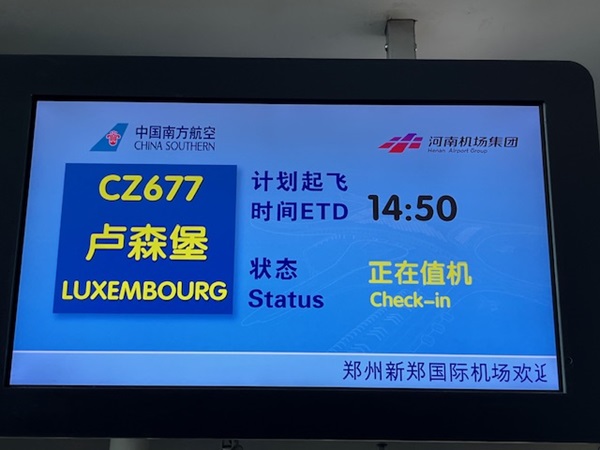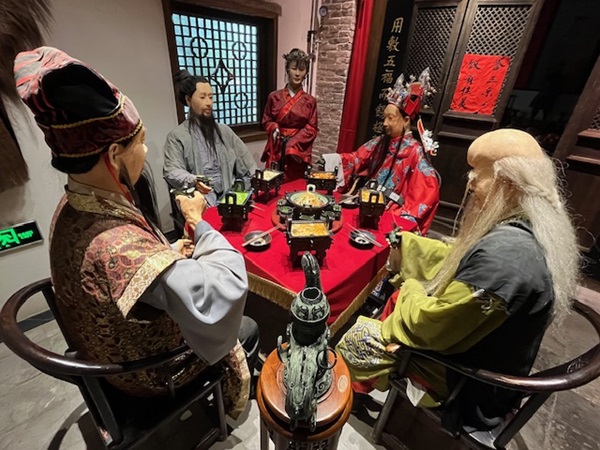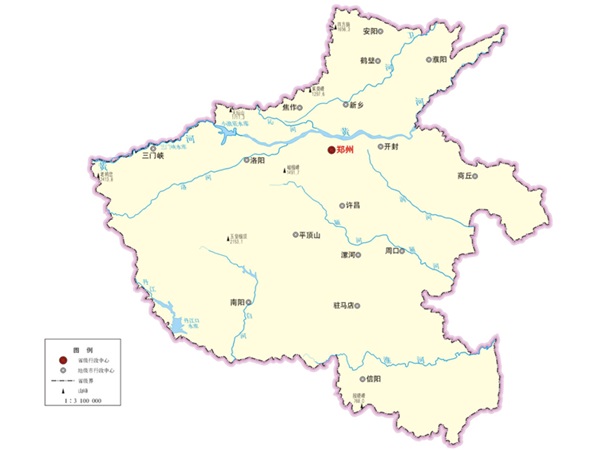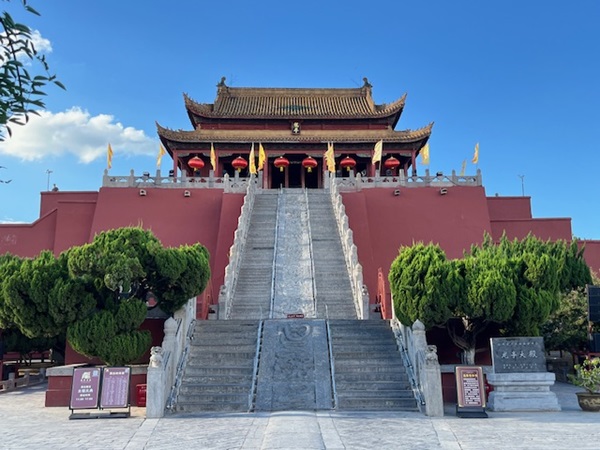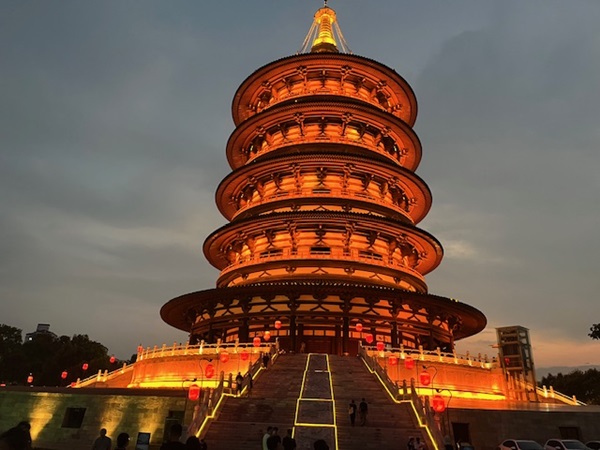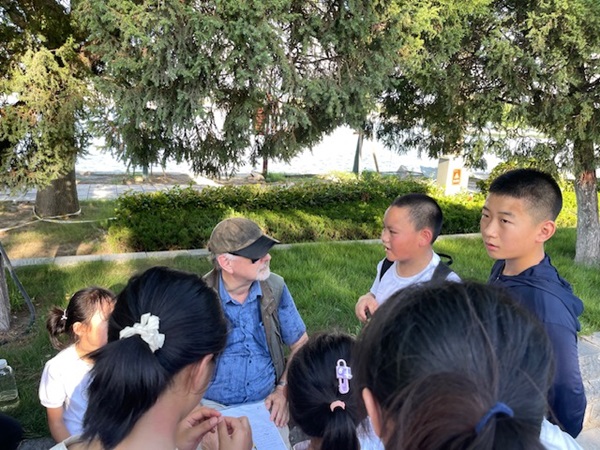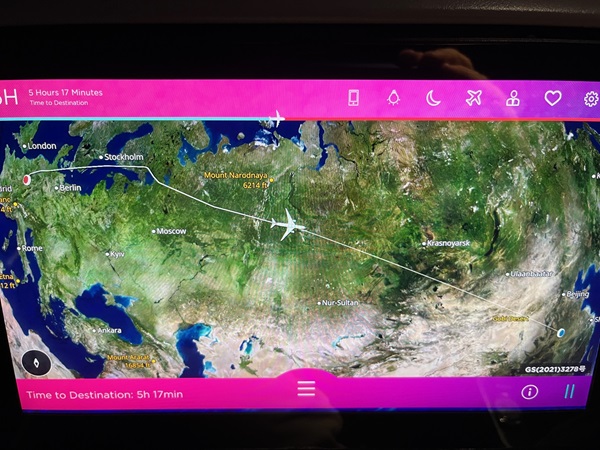 CSA route map to Zhengzhou;
Credit: Chronicle.lu
CSA route map to Zhengzhou;
Credit: Chronicle.lu
I recently got the opportunity to visit China, a country which I had not visited for 20 years: I had previously been to Beijing, Shanghai, Wuhan, Shenzhen and Guangzhou, as well as to Hong Kong and Macau, sometimes for leisure and sometimes for work, specifically project managing the implementation of EC-sponsored IPR training initiatives. Within that time, China has evolved beyond all recognition and is certainly much more prosperous; and Henan province is a jewel waiting to be discovered.
Back in 2014, when the Luxembourg Government announced that the Henan Civil Aviation Development & Investment Group (HNCA) had acquired a 35% stake in Cargolux, one of the Grand Duchy's most recognisable brands, an exciting collaboration was born. This initially allowed Cargolux entry into the Chinese market, both to import and to export goods, and it also enabled the start of a series of related projects and collaborations connected with the Air Silk Road initiative.
There was the announcement that HNCA was going to develop a significant regional cargo hub, and another one in which Cargolux and HNCA had announced a Joint Venture to develop a domestic / regional cargo airline, Henan Cargo Airlines, to both distribute within China cargo imported by Cargolux, and also collect it together for Cargolux to export it. More recently, HNCA announced the launch of a green bond on the Luxembourg Stock Exchange and Cargolux announced a new fire-fighting business unit and that they were exploring sustainable fuel technology.
Then, last December, China Southern Airlines (the largest airline in China of which 40% of the Henan component is owned by HNCA) announced weekly direct flights between Luxembourg and Zhengzhou, the capital of Henan province. So this is to where, and how, I travelled.
The fifteen-day visa-free initiative launched this year between China and six European counties, as well as the six-day / 144-hour visa-free initiative for those transiting through China, have made it easier than ever for tourists to visit China, a country which has initiated a series of reforms to open up the country to become more transparent to the west, often by dialogue and specific initiatives.
There are still challenges, not least concerning technology, with the US banning the Chinese telephony giant Huawei from participating in government contracts which was subsequently replicated by other western countries; then there is the additional challenge that China has blocked access to certain American / western online services such as Google and WhatsApp (China uses WeChat instead); nevertheless, I discovered that some people use VPNs to get around such restrictions.
Upon arrival, I got to learn that Zhengzhou was already an established rail hub, serving no less than eight separate regions by high-speed rail services (Hong Kong, for example, is just six hours away), before HNCA started investing in their Cargo Hub following their investment in Cargolux.
But first a quick introduction to China's rich history and culture. It has had many dynasties, with four arguably the most significant in relation to this trip and related series of articles:
- Han dynasty: 202 BC - 220 AD
- Tang dynasty: 618 AD - 907 AD
- Song Dynasty: 960 AD - 1279 AD
- Ming Dynasty: 1368 AD - 1644 AD
Zhengzhou city has a population of around 13 million, out of a total of around 100 million for the province of Henan, the second most populous province of China. We also visited Luoyang (population 7 million), Dengfeng (population 720 thousand) and Kaifeng (population 5.5 million).
The main tourism opportunities include myriads of temples and hundreds of museums; however, for the former, access for people of reduced mobility can sometimes be an issue as most temples are located on the sides of hills and there are many steps to climb; however, they are not steep and can be taken slowly and steadily. And the live shows are quite the spectacle!
Although it has not yet been developed as an international tourist destination (the domestic tourism market is very well established indeed), many museums and temples have information boards with English as their second language; some tourist guides also speak good English.
Accommodation is not expensive at all, and there are many western brand hotels operating in the major cities throughout Henan for those choosing not to use local options. A small percentage of staff speak English, and the hotels were remarkable as many have robots whose primary function is to receive outside food deliveries and bring them directly to one's room, even navigating lifts which have been programmed to communite with them.
Dining out is a way of life there, with a myriad of options available, most with late closing times. While they love using peppercorns when cooking, the cuisine is not that spicy and has many dishes one would find on the menu in a Chinese restaurant in Luxembourg, as well as many one would not find there; one local speciality is like a pancake folded around fried noodles and vegetables. While being able to use chopsticks is a distinct advantage, it is by no means necessary.
As I was often the only non-Chinese person at many of the tourist sites, I often had students (primary, secondary and university) come up to me to chat in English, and to have their photographs taken with me. I discovered then that English is now taught in all primary schools in China. This is certainly a very different country to what I had visited 20 years ago.
A couple of interesting observations before I provide some details on what we got up to... There are currently around 300 million cars on the roads in China, of which 18m are electric cars; within the last twelve months, 28% of new cards bought are electric cars: the changeover seems to have gathered pace in China faster than in some other countries. And most cars are now much larger in size than when I was there before. Also, some cities have dedicated motorcycle and bicycle lanes, separated from cars and trucks by traffic islands. Staying on the topic of driving, the significant investment in infrastructure is very evident, with high-quality roads both in and between cities, with multi-lane motorways, some of which are toll roads.
One specific activity that has been arranged concerned meeting with a local fishing club, Longxiang, a member of the Henan Fishing Association; we met at their clubhouse where we shared many fishing stories and photographs, before spending an afternoon on a lake fishing for freshwater bass using soft plastic lures resembling small crayfish (all fish caught were returned alive). The club members fish not only locally but also internationally, and they impressed upon me that they are currently seeking further opportunities of international collaboration and learning.
The series of articles related to this trip includes the following:
- Tourism: Zhengzhou; Lyoyang; Dengfeng; Kaifeng
- Business: Zhengzhou International Airport; HNCA; China Southern Airlines; Zhengzhou International Hub & BYD; Aviation Manufacturing Industrial Park
This introductory article will be updated with links to the others are they are published, to aid navigation and complete the story.

